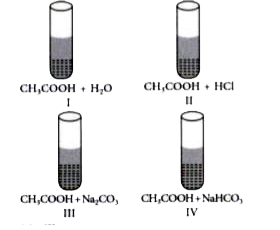Concentrated H2SO4 is added to the test tubes containing (a) to (e).
Test tubeCompoundsa.Cane sugarb.sodium bromidec.Copper turningsd.Sulphur powdere.Potassium chloride
Identify in which of the above test tubes, the following change will be observed on heating. Also give the chemical equations involved.
(i) Formation of black substance.
(ii) Evolution of brown gas.
(iii) Evolution of colourless gas.
(iv) Formation of brown substance, which on dilution becomes blue.
(v) Disappearance of yellow powder along with the evolution of a colourless gas.
(i) Conc. H2SO4 + Cane sugar Δ−−→ Black substance Conc. H2SO4 acts a dehydrating agent, hence it removes water from cane sugar on heating and forms a black substance known as sugar charcoal.
C12H22O11Conc.H2SO4−−−−−−−→12C+11H2O
Thus, formation of black substance occurs in test + tube (a).
(ii) Conc. H2SO4 + sodium bromide Δ−−→ Brown gas On heating NaBr along with conc. H2SO4, brown gas Br2 is evolved. Initially Hbr is produced, as HBr is a moderate reducing agent, it reduces H2SO4 to SO2 and itself is oxidised to bromine gas, Br2.
2NaBr+H2SO4Δ−−→Na2SO4+2HBr2HBr+H2SO4Δ−−→Br2+SO2+2H2O¯¯¯¯¯¯¯¯¯¯¯¯¯¯¯¯¯¯¯¯¯¯¯¯¯¯¯¯¯¯¯¯¯¯¯¯¯¯¯¯¯¯¯¯¯¯¯¯¯¯¯¯¯¯¯¯¯¯¯¯¯¯¯¯¯¯¯¯¯¯¯¯2NaBr+H2SO4→Na2SO4+Br2+SO2+2H2O–––––––––––––––––––––––––––––––––––––––––––––––
(iii) Potassium chloride + conc. H2SO4Δ−−→ colourless gas KCl on heating with conc. H2SO4, liberates HCl gas which is colourless.
2KCl+H2SO4(conc.)Δ−−→K2SO4+2HCl
since HCl is not a reducing agent, it does not reduce H2SO4 to SO2. Thus evolution of colourless gas occurs in test tube (e).
(iv) Cu turnings + conc.Δ−−→ Brown substance H2O−−−−→Blue soln.
Cu+2H2SO4ΔCAnhydrousuSO4+SO4+H2O
CuSO4+5H2OΔ−−→copper sulphateCBlueuSO4.5H2O
On heating, Cu turnings with conc.H2SO4, a brownish substance, i.e., a mixture of Cu turnings and white anhydrous copper sulphate is formed along with evolution of pungent smelling SO2 gas. On dilution, the solution turns blue due to the formation of hydrated copper sulphate which is soluble in water. Hence, formation of brown substance, which on dilution becomes blue occurs in test tube (c).
(v) Sulphur powder + conc. H2SO4Δ−−→
[H2SO4Δ−−→H2O+SO2+[O]]×16S8+16[O]→8SO2¯¯¯¯¯¯¯¯¯¯¯¯¯¯¯¯¯¯¯¯¯¯¯¯¯¯¯¯¯¯¯¯¯¯¯¯¯¯¯¯¯¯¯¯¯¯¯¯¯¯¯¯¯¯¯¯¯¯¯¯¯¯¯¯¯¯¯¯¯¯¯¯¯¯¯¯¯¯S8+16H2SO4Yellow powder→24SO2Colourless pungent smelling gas+16H2O–––––––––––––––––––––––––––––––––––––––––––––––––––
(v) On heating sulphur powder, which is yellowish in colour with conc. H2SO4, pungent smelling colourless, SO2 gas is produced, this yellow power disappears and the above reaction will occur in test tube (d).
Topper's Solved these Questions
- P-BLOCK GROUP 16 ELEMENTS - THE OXYGEN FAMILYBOOK - CENGAGE CHEMISTRYCHAPTER - P-BLOCK GROUP 16 ELEMENTS - THE OXYGEN FAMILYEXERCISE - Ex 3.1 Subjective (Give Reason :)
14 Videos
- P-BLOCK GROUP 16 ELEMENTS - THE OXYGEN FAMILYBOOK - CENGAGE CHEMISTRYCHAPTER - P-BLOCK GROUP 16 ELEMENTS - THE OXYGEN FAMILYEXERCISE - Ex 3.1Objective (Choose The Correct Option)
11 Videos
- P-BLOCK GROUP 16 ELEMENTS - THE OXYGEN FAMILYBOOK - CENGAGE CHEMISTRYCHAPTER - P-BLOCK GROUP 16 ELEMENTS - THE OXYGEN FAMILYEXERCISE - Archives Subjective
10 Videos
- P-BLOCK GROUP 15 ELEMENTS - THE NITROGEN FAMILYBOOK - CENGAGE CHEMISTRYCHAPTER - P-BLOCK GROUP 15 ELEMENTS - THE NITROGEN FAMILYEXERCISE - Exercises Archives (Subjective)
28 Videos
- P-BLOCK GROUP 17 ELEMENTS - THE HALOGEN FAMILYBOOK - CENGAGE CHEMISTRYCHAPTER - P-BLOCK GROUP 17 ELEMENTS - THE HALOGEN FAMILYEXERCISE - True/False (Subjective)
14 Videos
Similar Questions
Concentrated sulphuric acid is added followed by heating in each of the following test tubes labelled (i) to (v) :

Identify in which of the above test tubes, the following changes will be observed. Support your answer with the help of a chemical equation.
(a) formation of black substance
(b) evolution of brown gas
(c ) evolution of colourless gas
(d) formation of brown subtance which on dilution becomes blue.
(e ) disappearance of yellow powder along with the evolution of a colourless gas.
View SolutionConcentrated sulphuric acid is added followed by heating in each of the following test types labelled (i) to (v)

Identify in which of the above test tubes, the following changes will be observed. Support your answer with the help of a chemical equation.
formation of black substance
View Solution
Knowledge Check
In which of the following test tubes, the gas on evolution extinguishes a burning matchstick?
 AIII and IVBI and IICI and IIIDII and IV
AIII and IVBI and IICI and IIIDII and IVWhich of the following salts release reddish brown gas when heated in a dry test tube ?
ALiNO3BKNO3CPb(NO3)2DAgNO3
How are the following indicated in chemical equation ?
(i) Evolution of a gas (ii) Formation of a precipitate
(iii) Absorption of heat (iv) Evolution of heat .
View SolutionConcentrated sulphuric acid is added followed by heating in each of the following test types labelled (i) to (v)

Identify in which of the above test tubes, the following changes will be observed. Support your answer with the help of a chemical equation.
formation of brown substance which on dilution becomes blue.
View SolutionConcentrated sulphuric acid is added followed by heating in each of the following test types labelled (i) to (v)

Identify in which of the above test tubes, the following changes will be observed. Support your answer with the help of a chemical equation.
evolution of brown gas
View SolutionConcentrated sulphuric acid is added followed by heating in each of the following test types labelled (i) to (v)

Identify in which of the above test tubes, the following changes will be observed. Support your answer with the help of a chemical equation.
disappearance of yellow powder along with the evolution of a colourless gas.
View SolutionConcentrated sulphuric acid is added followed by heating in each of the following test types labelled (i) to (v)

Identify in which of the above test tubes, the following changes will be observed. Support your answer with the help of a chemical equation.
evolution of colourless gas
View SolutionA student added sodium hydrogen carbonate solution in ethanoic acid taken in a test tube and the gas evolved was tested with a burning splinter. Write the chemical equation for the evolution of this gas and its effect on burning splinter.
View Solution
